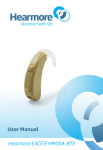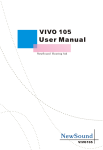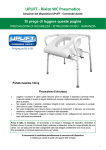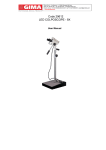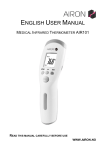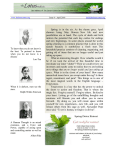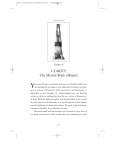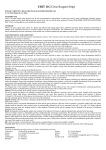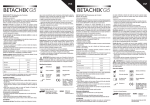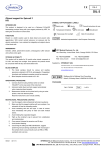Download User Manual
Transcript
User Manual BTE Contents Preface....................................................................3 Feature....................................................................4 How to ware your hearing instrument...................5 On and Off function................................................6 Volume control.......................................................6 M-O/M-T-O/N-H-O switch....................................7 Memory switch.......................................................7 Trimmer..................................................................8 Replacing the battery.............................................9 Troubleshooting Guide ........................................10 Low Battery Warning............................................10 Caring for batteries..............................................11 Cleaning................................................................11 Work condition....................................................13 FDA Information ..................................................14 1 Your hearing instr ument Hearing Healthcare Professional:___________________________ Model: □ LEFT ______ □ RIGHT _______ Serial No.: □ LEFT _____ □ RIGHT ______ Battery: □LEFT □ 312A □ A13 □ A10 □ A675 □RIGHT □ 312A □ A13 □ A10 □ A675 Warranty: _______________________ Low battery warning: □ YES □ NO Hearing program: □Program 1 _______________________ □Program 2__________________________ □Program 3__________________________ □Program 4__________________________ 2 Preparation Preface Congratulations! Welcome to a New Life created by NewSound Behind-The-Ear hearing instrument(called BTE here). Please read this manual carefully before using. Intended use Hearing instrument is a kind of electronic device which amplifies sound from your surroundings. It is used to help hearing impaired people recover hearing ability by compensating for the hearing loss for them.Your BTE is only one type of hearing instrument. Scope This user manual only applies to BTE hearing instrument. Precautions For middle ear infection patient, hearing instrument can't be worn until cured or follow your doctor's recommendation. Please consult your hearing healthcare professional first when you have any questions about your hearing or your hearing instrument. THE MANUFACTURER RESERVES THE RIGHT TO MODIFY WITHOUT ANY PRELIMINARY OPINION THE TECHNICAL SPECIFICATIONS OF THE PRODUCT. 3 Feature BTE's whose earhook connected with earmold (eartip) fits comfortably in your canal. 1.Earhook 2.Volume Control 3.N-H-O switch 4.Battery Door 5.Trimmer cover 6.M-T-O switch VIVO 100 VIVO Pro * VAN201 /200/400 VAN109 ASANA VAN209 1.Earhook 2.Volume Control 3.Memory Switch 4.Trimmer Cover 5.M-O(M-T-O)switch 6.Battery door P L * VAN201: no trimmer available. VAN Pro 4 Preparation How to Wear Your Hearing Instr ument Insert your earmold (or eartip) first, and then place the hearing instrument behind your ear. Insert your earmold (or eartip) correctly, on the basis of patiently practice. Please consult your hearing healthcare professional when you have some difficulty inserting the earmold. Step 1. Hold the earmold (or eartip) by the outer side near the tubing with your thumb and forefinger. Insert the canal tip of the earmold into your ear canal gently. Then softly press the earmold into place with your fingertip. Step 2. Carefully place the BTE behind your ear with the ear hook and earmold tubing wrapped over the top. Note: Before placing the BTE earmold (or eartip) into your ear canal, Insure the battery is inserted properly and the battery door is closed securely. If your BTE has an M-O (M-T-O)switch, ensure it is set to “O” (off) or the volume control is turned off before inserting the earmold(or eartip). 5 Operation On and Off Function Turn on your hearing instrument by closing the battery door completely. Turn off your hearing instrument by opening the battery door slightly. Note: Never force the battery door open or closed. FOR “VAN”: Hearing instrument can also be switched on by setting the M-O (M-T-O)switch at “M” position or switched off at “O” position. FOR “VIVO”: Hearing instrument can also be switched on by setting N-H-O Volume Control To adjust the volume, rotate the volume control by your fingertip up and down. The numbers indicates an orientation for the current volume setting. To increase the volume, turn the volume control up. To decrease the volume, turn the volume control down. 6 M-O(M-T-O) Switch |N-H-O Switch M-O (M-T-O) switch: Position “M”: The instrument is switched on. Position “O”: The instrument is switched off. Position “T”: Telecoil function for helping hear on telephone. N-H-O switch: Position “O”: The instrument is switched off. Position “N”: The instrument is switched on. Position “H”: Background noise reduction function. Memor y Switch Available for digital hearing aids only. Your hearing instrument can be programmed up to 3 different listening programs. When the hearing instrument is turned on, it will automatically be in program 1-microphone mode. The additional settings which are pre-programmed for your specific needs are accessed by the memory switch. Each time you press the memory switch, the hearing instrument will move to the next program. The sequence is 1, 2, 3, 1... Your hearing instrument will alert you to you help you identify which program you are using. When you select program 1 you will hear one beep, program 2 will emit two beeps, and so on. Please kindly note that the programs are set by your hearing healthcare professional or manufacturer. 7 Note: Under VAN200 and VAN 400 trimmer cover, there are programming socket and memory switch. This socket is used to connect your BTE with programmer. For hearing healthcare professional use only! Trimmer The number of trimmers on your instrument may be different from the following listed. Please adjust them according to the trimmer types on your instrument. H Trimmer: Used to eliminate noise. Turn clockwise for maximum low-frequency sound, minimum noise reduction. L Trimmer: Used to eliminate feedback. Turn clockwise for maximum high-frequency sound, minimum feedback reduction. P Trimmer: Controls the maximum output sound level. Turn clockwise for maximum sound amplification. 8 - + - + - + Note: Your hearing healthcare professional have set trimmers to match your particular hearing requirements. Please do not re-adjust by yourself. Replacing the batter y 1. Switch off the hearing instrument. 2. Open the battery door and remove the old battery. 3. Remove the protective foil from the new battery. 4. Insert the new battery sure with the plus (+) up. 5. Close the battery door. Important: Handle the battery door gently. The operation requires only a minimum of force. If there is any resistance when closing the battery door, ensure that the battery is correctly inserted. The door can not be closed if the battery is reversed. 9 Maintenance Troubleshooting SYMPTOM POSSIBLE CAUSES SOLUTIONS No battery Dead or low battery Battery improperly inserted Wax or debris in the earmold or eartip Low battery Excessive ear wax Volume set too low Improper insertion of earmold or eartip Insert battery Replace battery Insert battery correctly Hearing change Contact your hearing care professional Whistling, feedback Improper insertion of earmold or eartip Remove and reinsert the earmold or eartip Not clear or distorted sound Low battery Hearing instrument damaged Hearing instrument settings not optimal No sound Not loud enough Remove and clean the earmold or eartip Replace battery Consult your physician Turn the Volume Control up Remove and reinsert the earmold or eartip Replace battery Contact your hearing care professional Contact your hearing care professional Low Batter y Warning When you hear one short beep, it means that the battery is running out.You will hear the warning intermittently until you replace the battery. After the first warning, you may experience some reduction in sound quality. This is normal and can be remedied by inserting a fresh battery in the hearing instrument. Always remove the battery if your instrument is not in use for long periods. 10 Caring for batteries The performance of hearing instrument depends on the quality of the batteries used to a large extent. 1. Our hearing instrument, it is important to use high-quality batteries. The lifetime of a battery is influenced by the quality. With reliable batteries, you can avoid periodic hearing instrument failures. 2. It is also important that air should not enter the batteries before use. Each battery is therefore provided with an adhesive label that ensures that the batteries are sealed and fresh till use. 3. Never let an exhausted battery remain in the hearing instrument. Exhausted battery may leak and it would damage the hearing instrument. Cleaning Cerumen will accumulate on it while using your hearing instrument during use. It will damage the instrument if the cerumen enters it. Cleaning is easier when accumulated cerumen is dry; e.g., in the morning, before you insert the instrument into your ear. 11 Cleaning the instr ument Clean your instrument with a soft, dry cloth and the small brush. Do the cleaning on the soft table to avoid damage or scratch if the instrument fell. Do not use water or other fluids. 12 Appendix Working Condition Temperature should not exceed limits of –20°/60° Celsius at a relative air humidity of 65% for extended periods during transportation and storage. Air pressure between 500 and 1100 hPa is not detrimental to the instrument. Technical Data Maximum Output (2cc-coupler / IEC-118-7/2005 ) Manufactuer Wellkang Ltd t/a Wellkang Tech Consulting Suite B, 29 Harley Street LONDON W1G 9QR England, United Kingdom 13 FDA information Following the medical evaluation, the physician will give you a written statement that states that your hearing loss has been medically evaluated and that you may be considered a candidate for a hearing aid. The physician will refer you to an audiologist or hearing aid dispenser, as appropriate, for a hearing aid evaluation. The audiologist or hearing aid dispenser will conduct a hearing aid evaluation to assess your ability to hear with and without a hearing aid. The hearing aid evaluation will enable the audiologist or dispenser to select and fit a hearing aid to your individual needs. If you have reservations about your ability to adapt to amplification, you should inquire about the availability of a trial rental or purchase-option program. Many hearing aid dispensers now offer programs that permit you to wear a hearing aid for a period of time for a nominal fee after which you may decide if you want to purchase the hearing aid. Federal law restricts the sale of hearing aids to those individuals who have obtained a medical evaluation from a licensed physician. Federal law permits a fully informed adult to sign a waiver statement declining the medical evaluation for religious or personal beliefs that preclude consultation with a physician. The exercise of such a waiver is not in your best health interest and its use is strongly discouraged. 14 Notes Notes US HQ: 3948 Addison Woods Road, Frederick, MD 21704-USA E-mail: [email protected] www.usnewsound.com Version:0915E 6052- 002





















